Riverland’s Covid-Safe Welcome

Covid update May 2021:
It is with grateful hearts that we welcome our travelling friends back to Riverland and to New Hampshire.
Your hosts will be immune to Covid from April 30, 2021, and so can offer our customary hospitality without fear of suffering the symptoms of Covid 19. New Hampshire is doing a good job of vaccinating everyone and our case counts have fallen dramatically.
We are able to take reservations from travelers from all parts of the United States without quarantine. Travelers from outside the US must attest that they have remained in their homes for 10 days prior to arrival in New Hampshire. For more information, please see:
Bookings
Our enhanced cleaning protocols will remain as described below. Weekends (Friday through Monday) we will continue to only accept bookings that are at least two, consecutive nights. We will accept one-night bookings only on weekdays, Tuesdays through Thursdays.
Masks/Breakfasts
Our governor has also lifted the state-wide mandatory mask requirement. Out of an abundance of caution, we will continue to wear masks to ensure that we do not pass the virus to our guests. We ask that guests continue to wear masks while in the common areas of the bed and breakfast to ensure the virus does not pass between guests.
Breakfast will continue to be served in the rooms or on the porch, in fine weather, as guests prefer. Our cleaning protocols will remain as described below.
Immunity
We would be grateful if you would tell us on making a booking what your Covid immunity day was or will be. We are still required to ask about your health status on arrival and to ask you to sign a copy of the questions that appear below.
Covid protocol June 2020:
The pandemic has taught us many things:
- that gathering with friends and family is as essential as breathing,
- that we are all in this together and have our part to play, and
- that keeping everyone as safe as we can is the heart of hospitality.
A small, family-run bed and breakfast has some natural advantages. We have lower turnover, with fewer people passing through. Our one host stays on the premises. We have outdoor dining.
We are now able to welcome visitors from New England without quarantine. Visitors from other countries and states outside New England must attest that they have self-quarantined in their homes for fourteen days before arriving in New Hampshire. (Our governor is very concerned that out-of-state visitors will bring more Covid infections to New Hampshire.} We are looking forward to welcoming everyone as soon as we are able. We miss our friends “from away.” Please check back for updates.
We are already following guidelines that have been negotiated with the Governor’s Covid taskforce for the lodging industry:
Disinfecting and Sanitizing
We will leave rooms empty for three days between visits to ensure our all hard surfaces are naturally disinfected and all soft services are naturally sanitized, in addition to our regular, rigorous cleaning.
Research has shown that the Covid-19 virus lives on hard surfaces (metal, plastic) for up to three days and on cardboard for two days. Leaving rooms empty for three days will ensure that the virus dies of its own accord.
Riverland on the Merrimack is a gold-level member of the New Hampshire Department of Environmental Services Green Hospitality Program. We take pride in offering a healthy, nontoxic environment. Cleaning products exist that kill Covid, but they would challenge our own health and that of our chemically sensitive guests. We will let time do most of the disinfecting.
We will continue our rigorous cleaning, but add dilute bleach to the routine for handles, doorknobs, faucets, and other often-touched items.
Bookings
We will also require a two-day minimum stay, to further reduce turnover and mitigate exposure.
Breakfast
We will bring breakfast to your room on a tray or serve you on our lovely south-facing porch in fine weather.

Social distancing
Your host will prepare breakfast with mask and gloves.
Complementary masks will be provided so guests can protect themselves while interacting with others.
The governor’s working group mandates that we ask our guests from outside New England to attest that they have self-quarantined in their homes out of state for 14 days before arriving in NH and to answer the following questions when making a booking and again, at check in:
a. Have you been in close contact with a confirmed case of COVID-19?
b. Are you experiencing a cough, shortness of breath or sore throat?
c. Have you had a fever in the last 48 hours?
d. Have you had changes in your sense of taste or smell ?
e. If you answered yes to any of these questions, please do not put our employees and other guests at risk and come back another day when you feel better. Any deposit will be returned.
Riverland awarded Gold Status

Canterbury/April 2019 – “Going Green Brings in the Gold,” tweeted Kathy Black a Department of Environmental Services Pollution Prevention Specialist, raising Riverland from silver to gold level member of the New Hampshire Green Hospitality 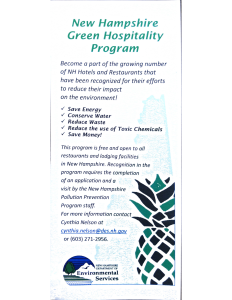 Program.Kathy and the NHGHP team recognized Riverland for energy-saving weatherization projects which have saved the growing three-room bed and breakfast 12 percent on its annual fuel bill over the past three winters. The projects included installing an efficient wood-burning fireplace insert and lining the chimney, creating an “airlock” by installing a second door which dramatically decreased drafts, and replacing a leaky, glass porch door with a well-insulated door and storm door. The team also made a short video about Riverland’s weatherization program….
Program.Kathy and the NHGHP team recognized Riverland for energy-saving weatherization projects which have saved the growing three-room bed and breakfast 12 percent on its annual fuel bill over the past three winters. The projects included installing an efficient wood-burning fireplace insert and lining the chimney, creating an “airlock” by installing a second door which dramatically decreased drafts, and replacing a leaky, glass porch door with a well-insulated door and storm door. The team also made a short video about Riverland’s weatherization program….
“We invested about $4,500 in all, “said Lucy Nichols, owner of Riverland on the Merrimack, “which will pay for itself in a few years, especially if oil prices keep rising. But the main thing is we are much warmer in deep winter and our guests are comfortable. I think a wood-burning fire is an essential ingredient to NH hospitality. A whiff of wood-smoke on a cold day always feels welcoming.” Since Riverland joined the program in May 2017, we have also installed a storm-water management system to move water safely out of the driveway and to reduce ice buildup. Riverland initiated a host of green practices when we joined the program including using green cleaning products, practicing water conservation and landscaping with native species, instituting extensive recycling, and installing LED lighting and energy star appliances. The NHGHP recognizes about 16 hotels and restaurants, which are listed on a map at the Department of Environmental Services website under the pollution prevention program.
Artisanal Craft Tour Visits Riverland

CANTERBURY, NH – The Cabin Fever Reliever artisanal craft tour will wind its away around Canterbury, Loudon, and Boscawen the weekend before Valentine’s Day, offering romantics an easy way to give handcrafted, NH-made items to their best beloveds.
The tour will call in here at Riverland on the Merrimack, a cozy bed and breakfast on the Concord-Canterbury line on Saturday, February 10 from 10 a.m. to 5 p.m. and Sunday, February 11 from noon to five. Join us for a cup of hot cider, conversation by the fire, and a tour of the B&B. We are 1.5 miles from Route 93, Exit 17. You can follow the signs or look us up at www.cabinfever.com.
Riverland is hosting artisans selling all manner of woolen goods and a smattering of stationery and pottery.
Lucy Nichols of New England Handwork, Canterbury, has been snugged up tight to fire during these cold weeks, knitting reversible wool/alpaca hats, mittens that double as puppets and puppets that double as mittens, and a child’s dress. Lucy also rescues, mends and finishes the vintage projects that linger in New England attics. She’ll have a rescued crazy quilt pillow for sale this year.

Misty Batchelder of Our Place Farm, Loudon, will be selling her hand-braided rugs, handspun yarn, and the lovely condiments she put up all summer long. She will also be demonstrating her crafts,
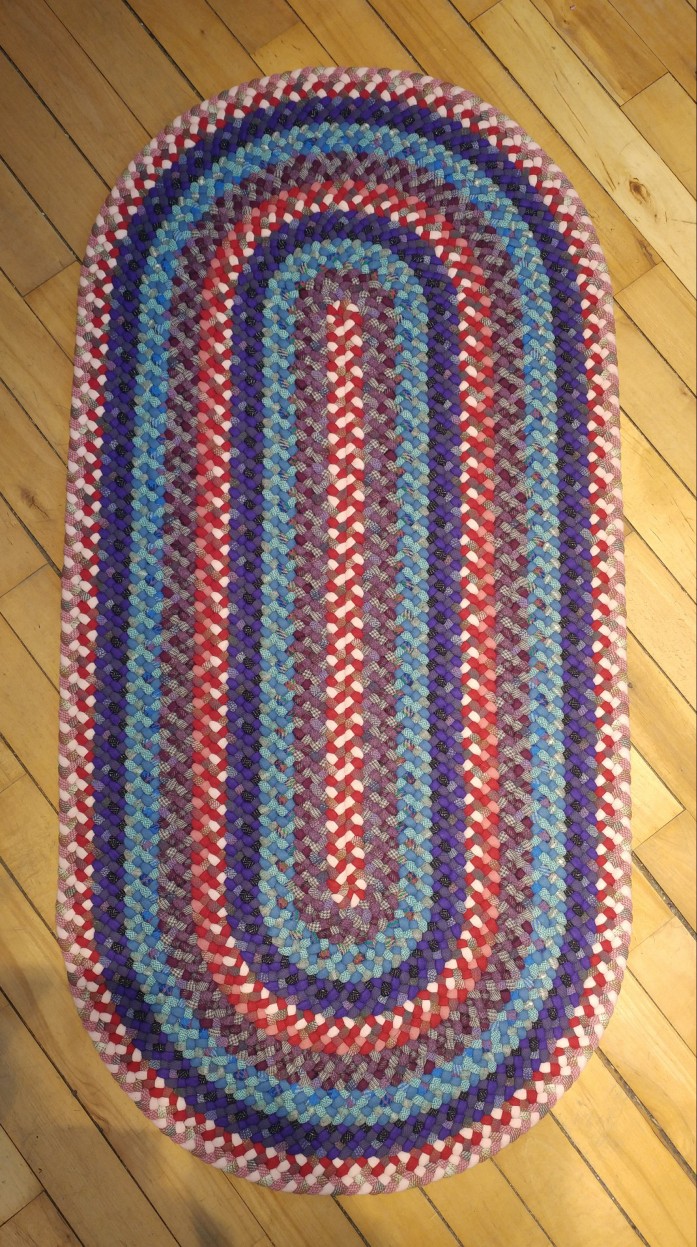
Cindy Lord of Peterborough works with wool fabric using a traditional technique from the early 1800s for making rag-rugs, mainly for the hearth. She cuts strips of wool and coils them, or gathers the strips and then sews them together to make small decorations, ornaments or pins. This technique has been called “Standing Wool” or more recently, “Quillie Rugs.” Her current favorite projects are sheep ornaments and pins, snowmen and pumpkins. She also enjoys making garlands and Penny Rugs, mostly traditional pennies or circle designs
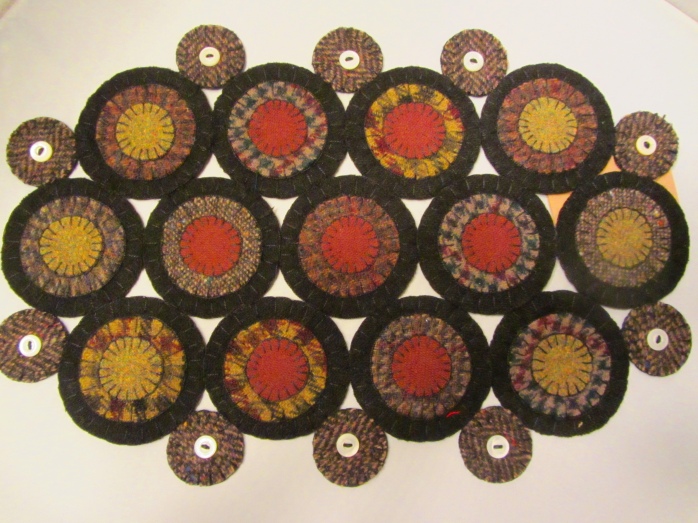
Lynn Littlefield of Concord of Unicorns, Dragons and Other Friends draws delightful creatures that adorn bookmarks, stationary, and other paper goods. From horses to hounds and dragons to the denizens of the New Hampshire woodlands, Lynn captures them in a friendly and natural style.
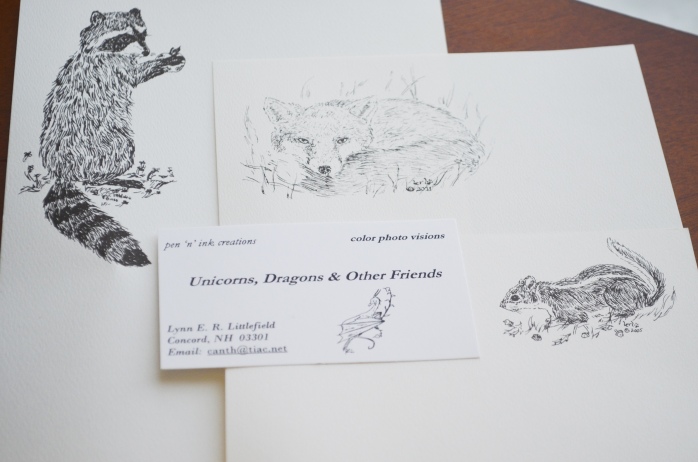
Susan Reid of Hopkinton also works in wool, with hand-knitted toy animals, felted purses and pots, and knitted placemats.
Noki Blanchard of Noki Pottery will be selling her hand-made crockery.

To learn more about the other stops on the tour, visit www.cabinfevernh.com and/or https://www.facebook.com/CabinFeverRelieverNH/.
American Sewing Guild Meets at Riverland

CANTERBURY, NH – A new sewing guild met here at Riverland for the first time January 8th members shared their sewing journeys and planned programs of mutual interest.
The American Sewing Guild (ASG) is dedicated to advancing sewing as an art and life skill. Small groups of sewists meet once a month to teach each other about sewing, do community service projects, make friends, discuss our creative passions, and show off recent creations.
The Upper Merrimack Valley Neighborhood Group will meet the second Monday of the month at Riverland on the Merrimack from 6:30 p.m. to 8:30 p.m. Co-leaders are Lucy Nichols and Kimberly Lavoie. On Monday, February 12, Kimberly Lavoie, a professional seamstress, will offer a program on the basics of sewing with knits and how to alter a T-shirt pattern. ASG is a membership organization; newcomers will be asked to join after two meetings. This new group is the only active group in New Hampshire, at present, although NH groups have existed in the past. We are part of the Boston Chapter of ASG. The new group will cater to a wide variety of sewing interests. The ASG website describes the guild as “…an organization of sewing enthusiasts who connect with each other at local, national and web-based levels for activities, communication, and networking. At the grassroots level, there are, what we call Neighborhood Groups (NGs) and Special Interest Groups (SIGs), which meet monthly or on a schedule established by the group members. Participants enjoy sewing programs presented by one of the members, or by an outside educator/speaker…
On a wider scale, sewing events are organized by the local ASG chapter a few times a
year. These may be a seminar or a hands-on workshop, presented by well-known
sewing educators. Field Trips, sewing retreats, and fashion shows are also popular
chapter events. Nationally, we have an Annual Conference which is the highlight of the ASG year. All ASG members (and non-members for an additional cost) are invited to attend this event.Participants take classes taught by their favorite sewing celebrity or author, while also having the opportunity to meet sewing industry representatives and fellow guild members from other states. The exhibit and vendor hall are favorites among attendees.
In short, the ASG Annual Conference has everything related to sewing for our members
to enjoy. Additionally, domestic and international tours of special interest to sewing enthusiasts are sponsored each year with special pricing for ASG members – an
opportunity to travel with sewing friends!” Newcomers are welcome. Send an email of enquiry to bostonasg@yahoo.com and more details will be sent to you.
Riverland Invasives: Learning by Doing

Canterbury, NH – Over the years, Riverland has become overrun by invasive species. The crew at Riverland on the Merrimack made a start this summer to cut them back, mow them down, and otherwise begin a program of remediation and control. We are learning as we go. We decided to blog about it, because we figure other people can learn right along with us about what works and what doesn’t work.
To our knowledge, we have five, vegetative invasive species: Asian Bittersweet, Multi-Flora Rose, Autumn Olive, Buckthorn, and Poison Ivy. This is only what we know about. We could use the help of an expert to map out the true extent of the problem and to create a credible control plan.
We also know that these plants have a big head start on us. We can see them everywhere, of course, but that’s not very scientific. Fortunately, NH Fish and Game has documented the scale of the problem for us. Their website has a map of “Priority Areas for Invasive Plant Management” by town. From their website, click on “Find Hotspots in your Community” and then, click on “Canterbury.”
Invasive plant management is a priority where ecologically important areas overlap with areas from which invasives are likely to spread. Riverland is a rare riverine habitat, prime farmland, and right on the river; invasives can easily spread downstream. To find Riverland on the map below, locate where the lower-left corner of the town line meets the river. Riverland is the property bordering the two, oxbow-shaped ponds.

Step 1: Mowing:
James Farquhar, bless him, does most of the mowing. He mowed the Riverland fields once in 2016, our first year here. The fields were a riot of golden rod and milkweed and had not been mowed in years. That’s him on our antique 1949 Ford 8N tractor in the photo below. Jon Hall of Gilmanton truly understands old tractors and is teaching us how to keep the old girl running. Fortunately, the bush hog is newer, because it is working really hard.
In 2017, James mowed the fields twice, and in some areas, three times. You can see in the 2017 photo that the mowing is beginning to bring back the grass and discourage the goldenrod/milkweed/ et. al. We estimate it will take another two summers of extensive mowing to bring the pastures back.

Step 2: Hacking back the jungle:
Autumn Olive and Asian Bittersweet are a bad combination. Bittersweet wants to climb and the autumn olive obliges by providing the scaffolding. These clusters of invasives can get to be two stories tall, and then climb over the top of nearby trees.
James, Jon, and son, Ben, spent two days hacking back the jungle shown in the photos below. As you can see from the photos, we found a truly beautiful Butternut tree in the center. The Butternut is a North American native which produces rich, butter-flavored nuts in late October, some years, when it feels like it, once it is 7-to-ten years old.

We figure other people may have an invasives problem also, so we are going to share how the crew brought this jungle down. This is just how we did it. We aren’t recommending any of these techniques per se. You will figure out your own path and take your own risks.
First, we got out the chainsaws and started hacking at the vines and anything else we could reach, wading deeper into the cluster as way opened. We kept a sharp eye out for trees we might want to keep and stuff falling from overhead. Slashing with a chainsaw in mid-air is dangerous, especially if you are standing on unstable slash. Some experience with a chainsaw is warranted.

Second, we got out the old garden rake and pulled the vines and pieces of branches out into the field as they rained down. You will see below why we raked. Then we cut some more autumn olive branches and bittersweet vines and raked some more until we could walk around the tree we discovered in the middle of the mess.

Third, we went to the back of the barn for our long-handled pruning tool and snipped the Bittersweet vines as high up as we could reach in the tree. Some of our vines were inches in diameter.
Fourth, Ben got a good hold on the now dangling bittersweet vines, and pulled. I mean, he really pulled. He had to be very careful that the branches did not break before the vines came down. We were not able to pull all of the vines out of the tree, so we left them there to turn brown and fall out in their own time. It was a good thing that the bittersweet had not yet set its berries, or they would have hung up there until some opportune moment to fall and reseed the bittersweet.

Fifth, you may wish to climb the tree in celebration, after the tree is free of smothering vines and undergrowth.

Sixth, we drove over the branches and vines and vegetation with our bush hog a few times to chop them up so they will compost in place. Bush hogs are amazing machines. Our Woods M5 can chop up branches up to about 3 inches in diameter. Stay way back. The shards fly like shrapnel.
It is probably best NOT to mow over branches when someone is sitting in the tree checking their messages.
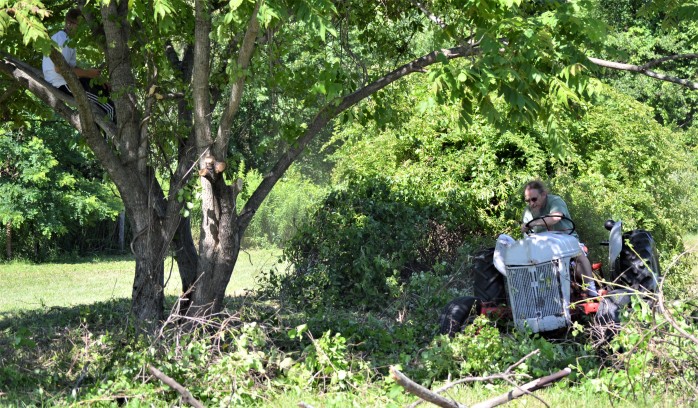
Seventh, we celebrated our hard work in full recognition that we will have to keep mowing around this tree, probably forever, to keep that mess from growing back.

Step 3: Removing obstacles to mowing and climbing frames.
As you can see in the photos below, we had a decrepit shed crowned in bittersweet. Although it was pretty in the fall, it was just one more thing to mow around and something else the bittersweet could climb. Did I mention it was rotten and didn’t have a roof? It had to come down.

First, Jon and Ben pulled as many walls of the shed as they could wiggle free. Fortunately, the shed didn’t offer much resistance.

Second, when all else fails, try brute strength. Let’s see how much comes down if I really pull.
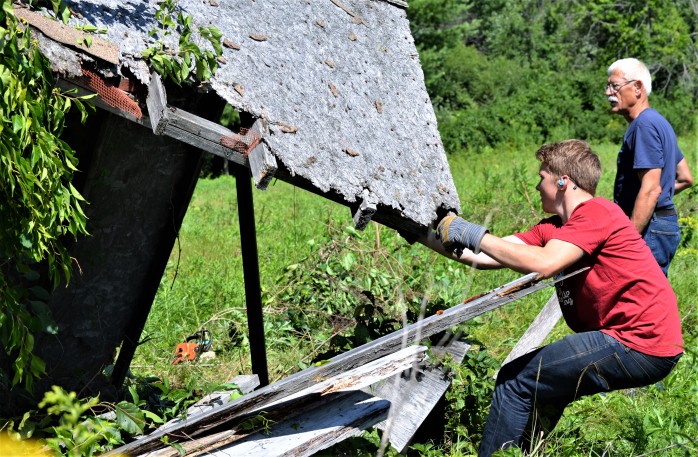
Third, when brute force is not enough, exert leverage on the corner that remains. This corner was entirely bound by bittersweet , which twined around the shed and the fence that ran nearby. The last bits of shed needed to be chopped free of the bittersweet before it could be entirely dismantled.

Fourth, James hauled most of the dismantled shed to the dump. The plywood walls showed signs of once having been covered in red paint. We didn’t know if that was lead paint and so, hauled it to the dump rather than burning it.

Step 4: Future work on invasives at Riverland…
The work of managing invasive species within the farm perimeter is going to take constant effort over many years. The autumn olive, mowed often enough, will probably eventually give up. And bittersweet with nothing to climb generally spreads across the ground, where it is a lot easier to mow…
However, it’s going to require endless mowing. We cut/mowed a large autumn olive bush out in the field in late June. The photo below shows how much it had grown back from the roots by late August.
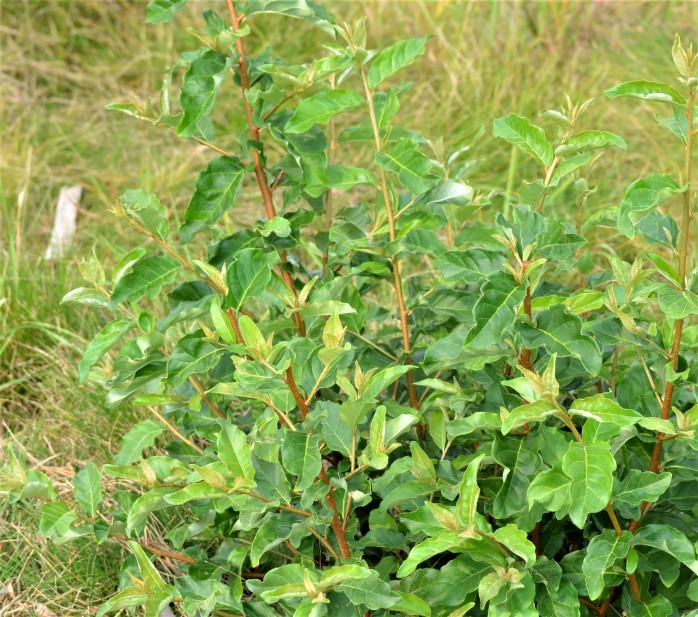
This fall, we hope to continue to clear the plants climbing our barns, for the sake of the buildings. It is time-consuming to pull bittersweet off buildings, because the little tendrils need to be pulled off by hand. James has half cleared one barn.

We also hope to continue working on the autumn olive bushes that grow all over the river edge of the field. They need to be chopped down one-by-one. The photo below gives some idea of the scale of the problem.

Next year, we will continue the mowing, to maintain the progress we made this summer, and to start to clear and to take down the internal fences, which are too hole-y to keep livestock in or predators out . We will also continue clearing the inside of our perimeter fence, working toward the day when it can be replaced also.
Until then, peace….
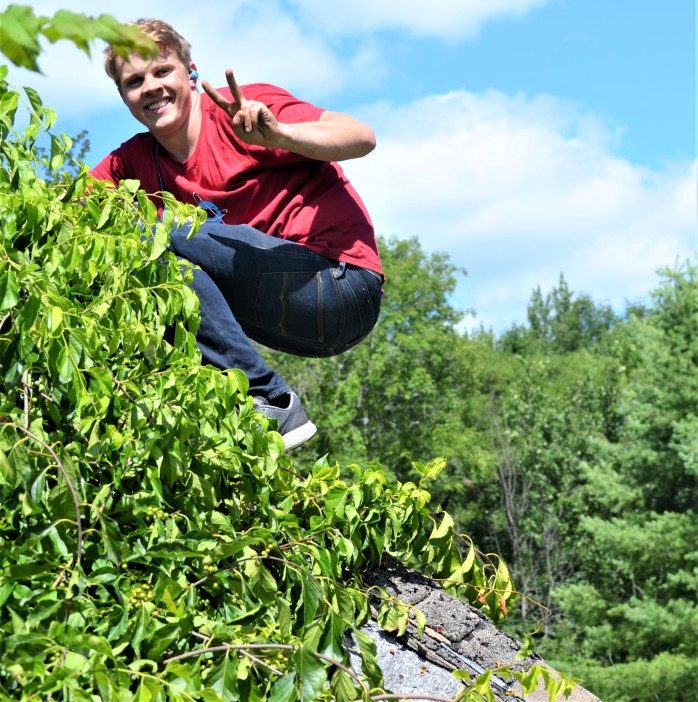
2017 Canterbury Fair

Welcome to a pictorial record of the 2017 Canterbury Fair in the Canterbury, NH town center, an annual, volunteer-run celebration of small-town community life.
The Canterbury Fair kicks off with the Woodchuck Classic 5k Road Race and 2K Chipmunk Classic Kids Run. It will also include traditional Morris dancing, children’s games on the green, a huge What-Not “tag” Sale, a used book sale, an abundance of live music, an antique tractor display including a Farmall for the kids to climb on, canoe polo on the fire pond, artisans and craftspeople, and delicious food.
4H Birding School Convenes at Riverland

Canterbury, NH/July 18. 2017 – The Canterbury Rascals and Cloverbuds 4H club visited Riverlands today to learn more about the birds that live here, the habitat, and the activity of birding itself.
Steve Hale, of Open World Explorers, began at the beginning, showing us how to use scopes and binoculars and how to follow birds as they moved through the foliage. He taught us how to make a “pishing” sound that mimics a bird’s alarm call and that tends to get the attention of other nearby birds.

The kids – ranging in age from about eight to high-school senior – spotted a lot of birds including a black and white warbler, a male Baltimore Oriole, a Great Blue Heron in flight, a green heron perched high in a tree and a red-eyed vireo, among many others. The kids heard a vesper sparrow that was too shy to show itself. The group identified 29 birds in all.

Steve, an engaging and practiced guide, leads birdwatching classes, lessons and tours around the state. He is particularly adept at identifying birdsong and calls, and directing the gaze of beginners in the right direction. Classes/lessons help beginner and intermediate birders progress in their knowledge, ability, skill and confidence as birders. Trips go to all northern New England habitats in search of resident, migrant and vagrant birds. Birding classes focus on practice identifying birds with visual field marks or songs/calls, and habitat associations.

He moved to New Hampshire from Louisiana in the mid-1990s, to work as a bird observer in the White Mountains, which led to a doctoral dissertation at the University of New Hampshire on the habitat of Bicknell’s Thrush. Steve created Open World Explorers in April 2016 to share his knowledge in ecology, ornithology and Earth Science to help others find value in natural history. Steve’s tours can go on foot, snowshoes, cross-country skis, kayak or stand-up paddleboard.
Laura Crockford, organizational leader of the Canterbury Rascals 4H group, said 4H is a positive youth development program that engages youth through various activities to become productive citizens in our ever changing world. Youth ages 8 and up (as of January 1st, 2018) are welcome to join our group. Contact Laura Crockford, Organizational Leader, at canterburyrascals4H@gmail.com. For more information, see here.

Officials deploy yellow cards in Wasp v. Beetle match at Riverland

Canterbury, NH (June 22, 2017) — The Feds showed up at Riverland today, hard on the heels of a small, green bug that is killing the ash trees in the wetland at the foot of our sandy bank, along the path to the beach. Theresa Murphy and Marci Murray, from the American Plant Health Inspection Service (APHIS), an arm of USDA, set out a new experiment designed to help slow the spread of this invasive beetle and to stem large expected losses to New Hampshire’s forestry industry.
Emerald ash borer (EAB), Agrilus planipennis Fairmaire, is an exotic beetle that was discovered in southeastern Michigan near Detroit and nearby areas of Ontario in 2002. The adult beetles nibble on ash foliage, but cause little damage. The larvae feed on the inner bark of ash trees, disrupting the tree’s ability to transport water and nutrients, which kills the tree. The adult beetles nibble on ash foliage, but cause little damage. The larvae feed on the inner bark of ash trees, disrupting the tree’s ability to transport water and nutrients, which kills the tree.
EAB probably arrived in the United States on solid wood packing material carried in cargo ships or airplanes originating in its native Asia and has been working its way East. It was discovered in NH in Spring of 2013, in an ash tree along a city street in Concord. It’s not yet known to be in Maine or Rhode Island, but it’s in all states south and east of us and in Canadian provinces to the north. http://www.emeraldashborer.info.
Last summer, Bill Davidson of the New Hampshire Department of Resources and Economic Development (NHDRED) began work mapping the spread of the infection in New Hampshire and introducing parasitic wasps that eat the EAB larvae, with the hope that they will eventually slow the spread of the infection. When Bill arrived, he, had just finished his master’s degree in entomology, with a research focus on EAB. He explained that the wasps would not reproduce fast enough to stop our ash trees dying here at Riverland, but when the EAB had exhausted their food supply, the wasp would hopefully go with them when they colonized new stands of ash, and would slow their growth in the new location.
He released the wasps, otherwise known as biological controls, into the canopy of the ash trees, with the hope they would breed and find the EAB, their host. These wasps are tiny and cannot sting people and are thought to have no other impact on our habitat. He reported briefly this spring that he thought they had established themselves; he planned a second release this summer to reinforce this nascent population.
Theresa and Marci, who work with Juli Gould in the APHIS office in Buzzards Bay on Cape Cod, explained that they are experimenting with three kinds of wasps to see which are more effective in controlling EAB and just how they work. The three are tetrasticus, affectionately known as “tets,” Spathius, also known as “spats”, and oobius. Tets and spats infect the larvae and oobius infects the EAB eggs.
According to Theresa, each EAB can lay 100 eggs and that they must kill 99 percent of the larvae to get an infection under control. Those are tall odds, which is why they expect the infection to keep spreading for the foreseeable future.
They are setting out sticky yellow cards on small, medium, and large ash trees, at both the top and bottom of the trees, to see where the “tets” wasps fly in search of EAB larvae. In previous experiments in Michigan, the wasps have flown to the canopy of the trees; in New York, they did not. The team suspects that the wasps look for EAB larvae under thinner bark, say in saplings or in the new growth at the tops of the trees. They will also be looking to see whether the oobius wasps are killing the EAB eggs.
Today, they were shooting lines into the trees with a big sling shot to which they will rig the cards. Technicians from the University of New Hampshire will come weekly during the summer to set out clean sticky cards and take the old ones back to their lab for inspection. The New Hampshire Technical Institute (NHTI) will host a similar experiment. Theresa said Riverland and NHTI were chosen because they each had a moderate EAB infection, small, middle and large ash trees in close proximity to each other, and a landowner willing to give permission.

Signs of an EAB infection include “blonding” on the bark (a light-colored patch), often with woodpecker holes where the birds have drilled into the bark to eat the larvae. As the trees become stressed, the leaves in the canopy become patchy and the tree compensates by sprouting leaves straight from the trunk. For more on signs and symptoms of EAB, click here.
To report a suspected EAB infection in New Hampshire,click here.
Theresa said the EAB could devastate the ash population in New Hampshire. “I don’t want to lose more forest or species,” she said. “I want it to be here for the next generation of people.” If we learn more about the basic biology, we will know better about where and when to release biocontrols next time.
Ash comprises an estimated 6 percent of New Hampshire’s northern hardwood forests or about 25 million trees. It accounts for about 2.6 million board feet of the 223 million board feet of wood harvested annually in New Hampshire, according to Brad Simpkins, state forester. The ash species accounts for an estimated $500,000 paid annually in stumpage fees to New Hampshire landowners and $1.15 million annual to lumber mills. These figures are from a 2013 article found here.
According to a 2013 Eagle Tribune article, Karen Bennett, a UNH Cooperative Extension Forestry Specialist, said it could cost $25 million to replace the thousands of ash trees found along city streets. She further estimated that the loss of the ash population could cost $1 million per year to industries that use ash, typically in cabinetry and flooring. Firewood sellers could lose another $500,000 per year. Click here to learn more.
Experts say moving firewood from place to place is driving the rapid spread of this invasive species. The state has quarantined the movement of all ash trees, nursery stock, and hardwood firewood in Belknap, Hillsborough, Merrimack and Rockingham counties. For more information, go here.
Memorial Day Observance 2017

Welcome to a pictorial record of the 2017 Memorial Day observance at the New Hampshire state veterans cemetery.

NH recognizes Riverland for Green Hospitality

Canterbury/Concord — The NH Green Hospitality Program (NHGHP) awarded its silver certification for sustainable hospitality on May 11, 2017.
A new initiative of the NH Department of Environmental Services (DES), NHGHP recognizes lodging establishments that conserve water, energy and other natural resources, reduce waste and toxins entering the environment and prevent pollution. The program also promotes recycling and purchasing greener products.
“We are an organic farm on conserved land on a sandy bluff above the Merrimack River, so environmental stewardship is a priority for us,” said Lucy Nichols, owner of  Riverland. “This is a relatively rare riverine habitat, home to many species that have few choices of where to live. We also have a beach, which is prime people habitat in the warm months. Our goal is to manage the property in ways that balance public access, employ best farming practices and bring this prime farmland back to productive use.”
Riverland. “This is a relatively rare riverine habitat, home to many species that have few choices of where to live. We also have a beach, which is prime people habitat in the warm months. Our goal is to manage the property in ways that balance public access, employ best farming practices and bring this prime farmland back to productive use.”
“Riverland has met the state’s standards for green hospitality at the silver level and is committed to continued improvement as part of recertification every two years. We are also in good regulatory standing with federal, New Hampshire and local environmental regulations. Read more at: https://www.des.nh.gov/organization/commissioner/p2au/pps/ppgh/index.htm.
So, what is Green Hospitality?
Every business is different and will apply the standards in different ways and will apply them differently over time. This is what Riverland has done in its first two years:
Riverland recycles. We ask our guests to discard trash, food waste and recyclables – glass, aluminum, newspaper, mixed paper, cardboard, and clean water and soda bottles – in separate bins. We further sort these recyclables and metal food containers and scrap metal, before we take it all to the Canterbury transfer station, where we pay $1/bag to dispose of trash.
Riverland conserves water: We have installed new, dual-flush toilets in our guest baths and are introducing low-flow shower and faucets, as we remodel. We change guest linens once a week for longer stays, unless guests request a change.
We have also planted native plants, which tend to be drought tolerant. They needed no watering during the very dry summer of 2016.
Riverland cuts electricity use. In our first two years, we have halved our use of electricity by reducing our use of air conditioning and installing LED lighting throughout.
Most of us in New Hampshire live without air conditioning as we are well North and our houses are well insulated. Many of us have a window air conditioner in just the bedroom for those occasional really hot nights, because who wants to miss out on a good night’s sleep?
At Riverland, we work with Mother Nature. On hot summer days, we keep the doors and windows closed during the day and open the windows in the evening to bring in the cool night air and then close the house up again in the early morning. This generally keeps us comfortable on the ground-floor. We do, however, have window air-conditioners in the bedrooms for those occasional heat waves and for the second floor. Even in New England, heat rises.
We ask our guests to help out by closing doors behind them and drawing curtains in their rooms during the heat of the day. We also ask guests to turn off lights and air conditioners when they leave their room.
Riverland reduces oil and propane use. We have also reduced our use of fuel oil by 125 gallons per year by insulating gaps around doors and windows. We burn wood in the fireplace many winter evenings, which helps offset our use of fuel oil.
We also minimize our use of propane for cooking and drying laundry. “On a good day, we hang our sheets and linens to dry outside, which gives them the best clean smell in the world,” said Nichiols. “We bring them in damp with the evening dew and iron them crisp with our Miele Rotary Iron for our guests’ comfort.”
Riverland reduces waste. Shopping local is one of the best ways to reduce fuel used in shipping products across the nation and the world and excess packaging, because packaging at the farmer’s market tends to be little to none. “Since we are small, organic farmers ourselves, shopping locally is something of a religion for us,” says Nichols. At this point, eggs are the only local food product we can find year-round, because … winter. We buy from the Concord Food Co-op and local farms, whenever feasible. We study ingredients carefully and chose organic and nearly organic products most of the time.
To reduce packaging, we also use pump-activated soap and lotion dispensers in our bathrooms, rather than individually packaged soaps and lotions. We also buy highly concentrated cleaning products that need to be diluted or are pre-measured in an exact dose.
In our purchasing, we avoid single-use products. The glasses in our rooms are made of glass and re-washed with each use. We use micro-fiber cloths in our cleaning, which can be washed and re-used.
And it probably goes without saying that we compost food waste and use newspaper to start the wood fire.
Riverland minimizes the use of toxins – inside and out. We are aware that many people have developed chemical sensitivities and carefully review the ingredients in our cleaning products, especially the frequently used dish and laundry detergents. Our Laundry detergent is Kirkland Signature Environmentally Responsible UltraClean Premium laundry detergent, which is certified by SaferChoice. Our dish detergent is Kirkland Environmentally Responsible premium liquid dish soap. Our cleaning products are Bio-Kleen and vinegar and water.
The following information sheet lists the ingredients in these products. The NHGHP program mandates that we use biodegradable products without phosphates and that we do not use: chlorine bleach, ethylene diamine tetraacetic acid or dinitrilotraacetic acid (EDTA), Nitrotriacetic acid (NTA), Monoethanolamine (MEA), 2-Butoxyehtanolar ethylene glycol monobutyl either (EGBE) or butyl cellusolve, methoxyethoxy ethanol or diethylene glycol monomethyl either (DEGME), alkylphenol ethoxylates (APE), Dibutyl Phthalate (DBP).
The conservation easement on our farm mandates organic management. We do not spray our foundations, because they do not need it. We choose native plants that generally do not suffer from pest damage. When needed, we use natural products allowed in the organic protocols.
